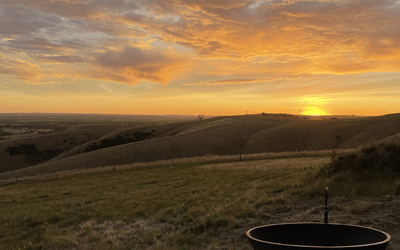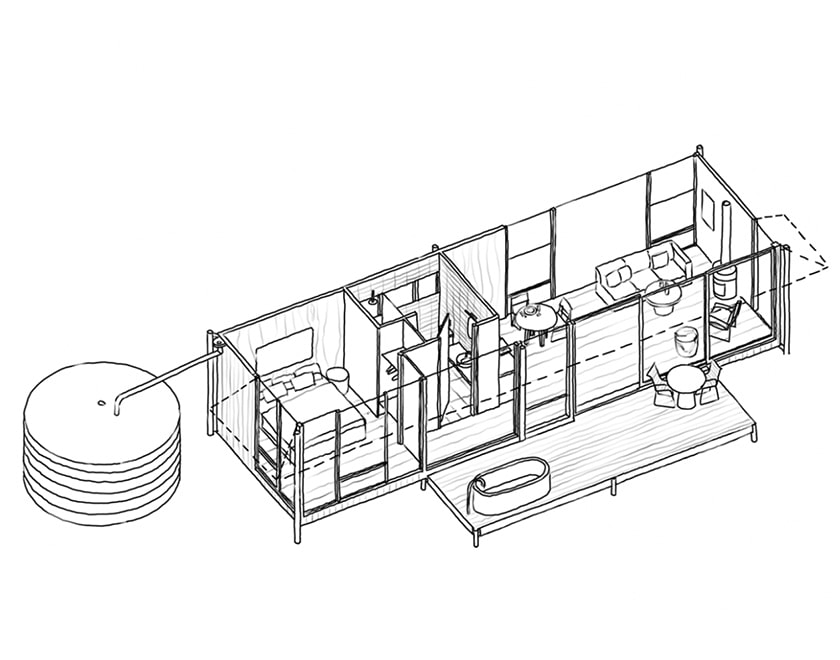Island bloom //
Discover a land of wild orchids and bioluminescent mushrooms.
Kangaroo Island’s abundant native flora frames its sense of place.
Around half of Kangaroo Island’s 4500 square kilometres is native vegetation – along roadsides and creeks, and in enormous expanses, particularly in the west and south. Much of the western reaches of Kangaroo Island were impacted by the summer bushfires of 2019-2020, and the recovery and regeneration of the native vegetation is astonishing. Whilst Spring is particularly beautiful on the island, you are sure to find blooms at any time of the year.
Since the bushfires, some unique and rare species have emerged on western Kangaroo Island including the rare Bolete Mushroom. There are species that have not been seen in almost a century, mostly fire colonisers, meaning they will thrive with fire and are at risk of extinction without it.

Autumn
It’s about the colours
Autumn invites nature lovers to Kangaroo Island and asks them to explore. The wind is low; the days are bright, clear and still warm; and winter rain has not yet kicked in. From late summer into autumn, the bush produces iconic and distinctly Australian seed pods. Vineyards dotted around the island bring a traditional warmth as leaves change from bright green to autumn hues.
Highlights
- Autumn tones of the Silver and Desert Banksia
- Gum trees and mallees are flowering in cream and pink – like the Narrow-leaf Mallee
- The Flame Heath begins its bright red flower display on small bushes

Winter
All about the mushies
Winter on Kangaroo Island brings a surprising plethora of colour as native plants begin to burst into flower. In every patch of scrub and expanse of national park, along roadsides and tracks, colour peeks through. It’s also well and truly msuhroom season!
Highlights
- The scarlet-flowered Running Postman is in bloom and the distinctive Native Lilac climbs over fences and trees. Tubular Correa flowers are displaying colours from green to red to salmon pink across the island.
- In Flinders Chase National Park and Kelly Hill Conservation Park up to 450 species of fungi, many of them rare, make themselves visible when it’s wet, and for some, who are reliant on fire, it is the first time they have emerged for decades.
- Discover Bracket Fungi, Ground Cups, Puff Balls, glow-in-the-dark fungi, and truffles that feed the Southern Brown Bandicoot

Spring
All about vibrant orchid blooms
By late September, any trail – Ironstone Hike in Penneshaw, a trail at Murray Lagoon, Beyeria Conservation Park or Dudley Conservation Park – is a painter’s paradise with rich palates of pastels to vivid hues. The pinks alone range from dusky tinges on Heath Myrtles and Velvet Bushes to ‘shocking’ on Tetrathecas. Scan the ground for the rich reward of the small, delicate, utterly gorgeous flowers too many to name.
Highlights
-
Acustom your eyes to the tiny flowers – and once you see one in the leaf litter, you’ll see dozens – Pink Fingers, Daddy Long-legs, Helmet Orchids, Donkey Orchids, Greenhoods and Sun Orchids.
-
The pea flowers, mostly yellow and red, come into their own in October, and the showiest of all is the Cockies Tongue with its large orange-red flowers.
- Old Man’s Beard covers bushes and trees and creamy rice flowers dot roadsides. Wattles flower cream, lemon, canary and apricot – each species to its own tone.

Summer
It’s time for pea flowers
The local hop bushes, of which there are three varieties, come into their own as the weather warms, displaying coppery to purple fruits that cover the small shrubs. Bronzed flower tassels hang heavily on male she-oak trees and flowering mallees will be simpler to find amidst a chorus of feeding parrots and honeyeaters.
Highlights
-
Many pea flowers, mostly yellow and red, but also pinks and purples, last well into summer growing low to the ground.
-
The endemic Green Correa is flowering, and the velvet bushes continue their elegant show, as does the island’s only native bottlebrush, Scarlet Bottlebrush.
-
The samphire meadows along Chapman River glow red against the grey soil and shedding trunks of the melaleuca paperbarks, who put on a white-cream flower show from late spring through summer.
Good to know.
Fire plays an important role in Australian landscapes, with many native plants and vegetation communities in fact evolving to depend on it. For some species bushfire events trigger seed germination, after seeds have lay dormant in the soil for decades. With research discovering that bushfires help provide nutrients specifically needed by native vegetation to rejuvenate and seed.
The remains of burnt trees, with hollowed out logs, provide important refuge for birds and mammals seeking shelter and nesting.
Keep your eye out for any wild blooms on Kangaroo Island.
Keep Wandering.
B Corp Certification
We are B Corp Certified. After a rigorous two year assessment process, Wander is proud to announce that we have achieved B Corp Certification! What does that mean you ask?Well, as of now, Wander is part of a global community of more than 8000 companies in 96 countries...
Women driving change
Five Women Shaping Our Communities.Here's to the trailblazers, tastemakers, and trendsetters—the women who are transforming how we care for our planet, our heritage, and our neighbours through innovative approaches to sustainability, culture, and community. They...
Wellness on Kangaroo Island
Nurture yourself in nature's embrace //In our fast-paced world, finding time to replenish our spirits has become a vital pursuit for many. Kangaroo Island offers a unique opportunity to intimately connect with abundant natural beauty in order to nourish a stronger...








